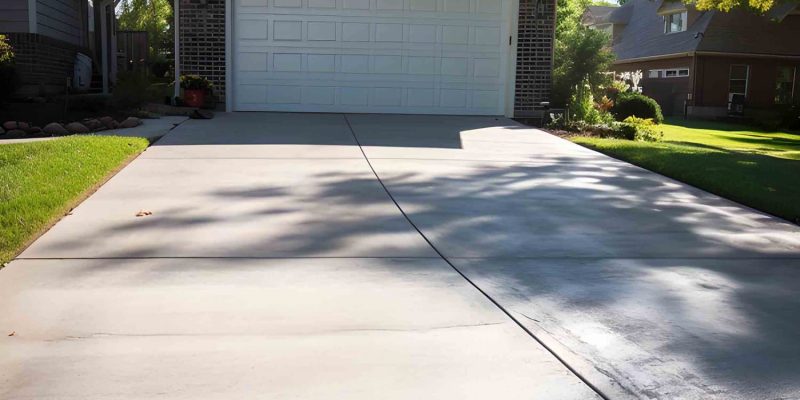Whether choosing a designer concrete finish or a simple gray slab, few driveway decisions have as much impact on both aesthetics and durability as proper thickness. Achieving long-lasting stability and performance requires considering vehicle weights, drainage, climate extremes and other critical factors. This guide serves as your concrete driveway thickness 101—a primer on determining and requesting the ideal depth for your Des Moines home.
Local Building Code Requirements
Before determining other thickness factors, we reference Des Moines’ building code as an official baseline.
Reference local building codes
Regulations mandate a 4 inch residential driveway minimum, whereas commercial development projects often require upwards of 6 inches for enhanced durability under heavy vehicle traffic. Building inspectors may dictate thickness based on submitted site plans to account for poor soil conditions or retention of large vehicles. Your contractor can advise on deviations from code to suit specific vehicles like a loaded moving truck or RV needing diagonal access.
TIP
For special residential requests that vary from the norm, include a written justification to avoid rejection purely based on slab depth precedent. When planning custom touches like integrated lighting or specialized finishes, confirm any impact to the mandated pour thickness in our zone.
Base Material and Drainage
The subsurface beneath your concrete makes a huge impact on long-term stability. A well-graded base of packed gravel, crushed stone, or other aggregate creates crucial support.
Driveway Base
Excavate 4-12 inches down, remove poor soils, compact remaining material, and build up the ideal base to prevent shifting, settling cracks over time. Proper slope facilitates water runoff so moisture doesn’t undermine integrity or lead to ice buildup. We recommend a 1% diagonal grade minimum, but steeper driveways or low areas may require 2-3% to negate heavy Iowa storms.
Slope considerations
If existing walkways or structures limit slope options, a thickened edge or subsurface drain tiles assist drainage. Though not visible, an intentional base and slope unlocks decades of driveway durability. Take advantage of experts’ grading knowledge even if thinning the concrete marginally to allocate funds towards base improvements.
Driveway Use and Vehicle Weight
The vehicles utilizing your driveway determine the necessary concrete thickness more than any other factor.
Standard residential access for family passenger cars permits a 4-5 inch pour. This provides plenty of integrity for daily use without overspending. However, regular traffic from even mid-size pickups, company vans, or heavier SUVs warrants investing in a 5-6 inch thickness minimum.
Over 10,000 lbs vehicles like duallies, RVs, fire trucks, or semi-trailer access require specialized 6 inch industrial concrete or thicker to prevent rapid deterioration, tire imprints, or cracks over years of strain.
Planning ahead
Despite the thickness leeway our building codes provide, we recommend planning for the heaviest vehicle that could reasonably utilize the driveway now or in the future. Sacrificing specialized finishes to pour a 6 inch base slab is ideal for homeowners who occasionally transport equipment for hobbies, own transient teen vehicles, or may move different trucks through over decades of property ownership. An ounce of extra thickness yields pounds of vehicle flexibility without sacrificing durability.
Weather and Climate Considerations
Des Moines endures temperature swings from 100°F summers to subzero winters, which can wreak havoc on concrete integrity over time.
Freeze/thaw cycle impacts on thickness
The subsequent freeze/thaw cycles force most area contractors to recommend a 5-inch residential thickness minimum to withstand the expansion and contraction of our 70° average annual shift. Concrete poured at a 4-inch depth still meets code here, but risks developing wide capillary cracks that fill with water, expand, and erode the driveway. Each winter’s melt/refreeze worsens this fragmentation exponentially.
Adjusting for heavy snow
Similarly, the freeze potential beneath heavier snow loads dumped by plows means we recommend strength doses of air entrainment admixtures and high early cement to properly set thin edges that withstand million pound scraping force. Skimping on design precautions that counter the whims of Midwestern seasons often leads homeowners to replace seemingly sound slabs after just 5-7 years. Think long-term with thickness and concrete specialized for our fickle weather rather than budget-friendly quick fixes. The difference of an extra inch or properly timed finished concrete in advance of early wintry mixes could save thousands in premature replacement.
Increasing Edge Thickness
The driveway edges adjoining landscape beds or exposed to turning tires sustain the most abrasion long-term.
Why edges often fail first
Settlement, erosion, and lack of lateral support also increase movement at the margins versus the center slab. Asphalt aprons, curb cuts, and tactical plow positioning further stress the thin boundary lines. We observe edge deterioration on projects with uniform depth years before central cracking appears. Though you may not use the entire paved width, protecting the perimeter preserves driveway accessibility and avoids trip hazards.
Thicker edges for stability
We suggest requesting an isolated edge thickening of 2 inches tapering down 12 inches in from sides. For maximum stability, thicken the final 4 feet of residential driveways approaching garages to accommodate velocity and turning strain from vehicles. If your budget only allows enhancing certain sections, focus on fortifying edges and leave central areas at code minimums. Curb appeal and safety hinge on durable borders that contain the overall slab.
Driveway Reinforcement Options
For residential driveways beyond 6 inches thick, many Des Moines contractors recommend reinforcing the poured concrete to prevent cracking under strain.
Steel rebar grids provide incredible tensile strength against heavy loads and settlement shifts. Synthetic macro fibers offer an alternative to reduce plastic shrinkage cracks that form as concrete dries. These materials cost marginally more than plain concrete but ensure suitable structural performance decades down the road.
Conclusion
Choosing the perfect concrete thickness is crucial for both visual appeal and long-term durability. Consider building codes as a starting point before evaluating thickness boosts to account for heavy vehicles, extreme Iowa weather, marginally supported edges, and future flexibility needs. Though minimal compliance saves money upfront, the difference of an extra inch or two prevents expensive early repairs down the road. Now that you understand the core considerations for determining your ideal concrete depth, you can contact our team to request a free quote today.

